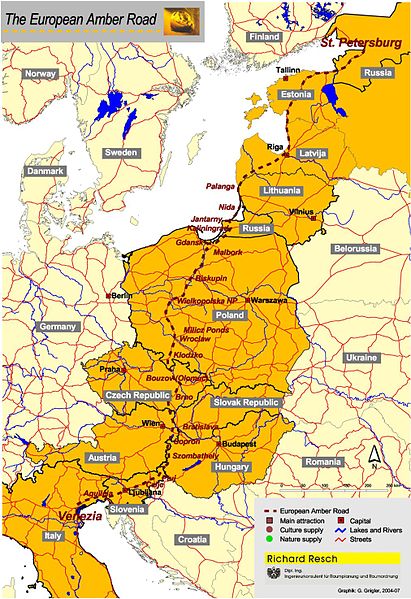The Amber Route

Forty, fifty or some many other
million years more ago, long before man existed
to make the Amber Road, resin dripped down the trunks of
prehistoric pine trees. Insects, plant seeds, little frogs,
even small lizards got trapped in the tacky surface of what
the ancient Greeks called the "tears of gods". Caught and
covered by the resin that hardened with time they were
preserved to be seen today in the "gold of the sea."
The waves of the Baltic Sea have thrown this "gold" of
the sea ashore since days of old. And as long a memory
exists, man carried this gold south along routes that became
known as the Amber Road.
Like the Silk Road in
Asia the Amber Road
connected different cultures and nations
between the Baltic and the Adriatic Sea. It was really a
series of roads and waterways that for centuries led from
Europe to Asia and vice versa, and from northern Europe to
the Mediterranean.
A vital component of ornamental
objects, amber was transported overland on rivers from the
North Sea and Baltic Sea coasts to Italy, Greece, Black Sea
and Egypt long before the birth of Christ and long after.
The Egyptian pharaoh Tutankhamun had Baltic amber among his
burial goods, and amber was sent from the North Sea to the
temple of Apollo at Delphi as an offering. From the Black
Sea, trade could continue to Asia along the Silk Road,
another ancient trade route.
The amber road went
different directions, depending upon whom was in power.
In 225 BCE, the Romans inflicted their first major
defeat upon the Celts,
who at this time occupied the entire
Po valley. Whatever amber managed to get into Italy came by
way of the sea, or as trade through the Celts. During the
first millennium BCE, Rome was beginning to push the Celts
back into upper Germany. However, the amber source, the
Baltic Sea, still remained out of Rome's direct control. By
now routes were open to the Danube valley, and an overland
amber route established. This went from the head of the
Adriatic Sea around the east flank of the Alps and through
Austria and Poland to the Baltic.
As demand for
amber grew, Rome became more interested in cutting out the
middlemen and dealing direct with the source, where-ever
that was. Emperor Nero sent a small exploration party up the
amber trail with orders to seek out the source. When the
soldiers returned, they carried with them a huge load of
amber, and the news that the source was so far away that
Rome could never protect those sent to take it. Over half
the route was through the lands of their ancient enemy, the
Celts. While at the moment they were peaceful, they could
not be trusted, especially if Rome was to take away such a
lucrative source of income. If Rome could not control the
source, they could at least make the distance as short as
possible and cut the price of amber down a bit. With this in
mind, Emperor Claudius set out to pave a road across the
Alps.
Source: http://www.coincommunity.com/forum/topic.asp?TOPIC_ID=107015

